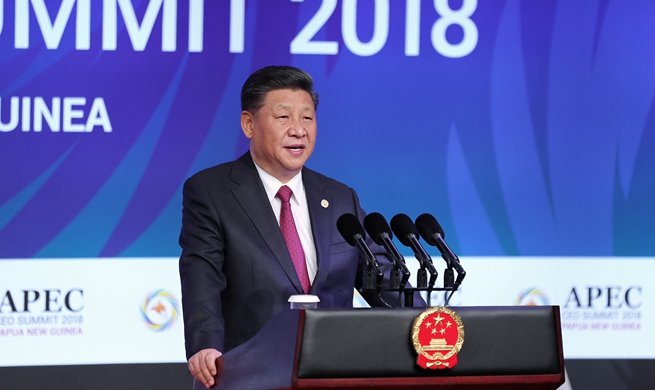BEIJING, Nov. 20 (Xinhua) -- Under a blue spotlight lies a mouse's brain immersed in liquid. A diamond blade slowly peels off a layer of brain tissue that is only one micron thick.
The layer is scanned and imaged. About 10,000 layers will be peeled off to get a map of the whole mouse brain.
The images of the colorful neural and vascular systems of the brain shown on the computer look like intricate highway networks. This is the world's clearest map of a mammal brain.
Dozens of such instruments are working round the clock in the spotless labs of the Suzhou Institute for Brainsmatics of the Huazhong University of Science and Technology (HUST), located in the Suzhou Industrial Park, in east China's Jiangsu Province. Nearby are the ancient Suzhou Gardens, famous for their inventive and exquisite design and oriental aesthetics.
The journal Nature recently reported the construction of the brain-imaging institute in Suzhou, arousing great interest in academic circles.
"We have achieved success with mice, and are making efforts to map the brains of primates which are more advanced and complicated," says Li An'an, vice-director of the institute.
"Our ultimate goal is to lead the world to get a precise map of the human brain, which will help us uncover its secrets," Li says.
This is only one of China's achievements at the frontier of science and technology.
In his book on Science and Civilization in China, Joseph Needham, a British science historian, described China as a great country of invention and creation, but falling behind in modern times.
In the 20th Century, few Chinese participated in world's major scientific and technological advances.
But the situation is changing rapidly. From Internet development to brain study, from probing space to exploring the deep sea, from observing the universe to researching micro particles, Chinese are working in almost all fields of science and technology.
In a cave in Wuhan, capital of central China's Hubei Province, scientists from HUST have measured the gravitational constant for more than 30 years, and obtained the most accurate result in the world recently.
Isaac Newton discovered the principle of gravitation more than 300 years ago, but the measurement of the gravitational constant had always been inaccurate.
"Precise measurement of gravitational constant is important for deeper understanding of gravity, and the measurement technology could be applied to searching for mineral deposits and navigation. The study might also help us figure out whether the universe has additional dimensions as surmised by Stephen Hawking, which might enable humans to traverse space and time in the future," says Tu Liangcheng, director of HUST's gravitation center.
China has intensified efforts to explore the universe in recent years to reclaim its pride in its outstanding achievements in astronomy in ancient times.
As early as 4,000 years ago, China had full-time astronomy officials and the world's earliest record of Halley's comet. The length of a year was measured and determined by Chinese astronomers more than 700 years ago, in line with today's Gregorian calendar.
China recently built the Five-hundred-meter Aperture Spherical Radio Telescope (FAST), the world's largest single-dish radio telescope. It has discovered dozens of new pulsars.
Scientists at China's Purple Mountain Observatory (PMO) and other institutions are pushing forward the construction of an observatory on the inland icecap in Antarctica.
"That will definitely be a world leader," says Shi Shengcai, director of the department of Antarctic and radio astronomy at PMO.
Completed in 1934, PMO was the first modern observatory built by Chinese. The original intention of constructing it was to avoid the monopoly of astronomical research by Western colonialists in China.
In its beautiful newly built office park in the suburb of Nanjing, capital of Jiangsu Province, scientists are working on the next-generation space detector to search for dark matter.
Chinese ideologist and philosopher Zhuangzi, who lived more than 2,000 years ago, believed material structure could be divided infinitely. Chinese scientists today continue exploration of the microcosmic world, with many breakthroughs in recent years in fields such as quantum communication, neutrino and iron-based superconductivity.
The Suzhou Nanomicro Technology Co., Ltd. is a private nano technology firm. It develops nano material that looks like white powder, but is actually tiny spheres thinner than hair with strong absorbability, which can be used in pharmaceuticals and liquid crystal displays.
"We have broken the technical monopoly of the United States and Japan, and saved hundreds of millions of dollars in import costs for China," says Jiang Biwang, chairman of Nanomicro.
More young Chinese are involved in innovation. The Suzhou Novosense Microelectronics Co., Ltd. was set up five years ago to develop core chips for sensors and isolators. All the founders of the company were born after 1980.
Wang Shengyang, CEO of the firm, says that R&D personnel account for more than half of the staff.
Statistics show China's R&D investment in 2016 exceeded the total of the EU, and was second only to the United States, accounting for 21 percent of the global R&D investment. China has the world's largest number of R&D personnel, and ranks second in the world in the number of scientific papers published in international journals. Scientific and technological advances contribute to 55.3 percent of the economic growth in China.
China has resumed its place as a major contributor in science and technology thanks to the reform and opening up policies. At a national conference on science in the spring of 1978, then Chinese leader Deng Xiaoping emphasized the role of science and technology as a productive force.
Since the 1980s, China has issued a series of policies and guidelines to promote the development of science and technology.
Gan Lin, director of the R&D center of the National Supercomputing Center in Wuxi, says China made an early plan for supercomputing research. One approach was to introduce foreign technology, and the other was self-reliance.
The Sunway TaihuLight, China's fastest supercomputer, is a result of the second approach, with 100 percent of its components, including its chips, designed and made in China.
The Sunway TaihuLight was the world's fastest supercomputer in 2016 and 2017. With it, Chinese researchers won the ACM Gordon Bell Prize, known as the "Nobel Prize" of supercomputing application.
"The decision of self-reliance was great. Core technology cannot be bought," Gan says.
In 2006, China made a medium and long-term plan on the development of science and technology to 2020, which focuses on innovation.
Innovation has gradually been recognized as a driving force to transform China from the export-oriented and low-cost manufacturing development model to a knowledge-based and sustainable development model.
China has also ended the closed-door policy. "The research of astronomy needs international cooperation," says Shi of PMO.
China's economic miracle has begun to boost science and technology. The construction of the Suzhou Institute for Brainsmatics received an investment of 450 million yuan (about 65 million U.S. dollars).
In Wuhan East Lake High Technology Development Zone, the government is investing a huge amount of money to build an international school and a children's hospital to attract world-class scientists and technologists.
China also promotes the development of science and technology through institutional innovation.
The Southwest Jiaotong University in Chengdu, capital of southwest China's Sichuan Province, and other Chinese universities are testing a bold reform to allow researchers to enjoy part of the patent rights for job-related inventions. Previously, the patents belonged to the universities.
As a result of the reform, creativity has been encouraged and the number of patent applications has risen sharply.
Over the past five years, China has leaped in scientific and technological advancement. Innovation has been given priority and more and more Chinese understand that innovation is the primary driving force of development to underpin the growth of a modernized economy.

















